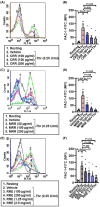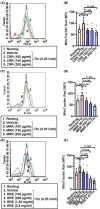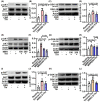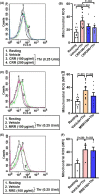Ayurvedic preparations of Raudra Rasa inhibit agonist-mediated platelet activation and restrict thrombogenicity without affecting cell viability
- PMID: 37787005
- PMCID: PMC10699108
- DOI: 10.1002/2211-5463.13713
Ayurvedic preparations of Raudra Rasa inhibit agonist-mediated platelet activation and restrict thrombogenicity without affecting cell viability
Abstract
Ayurveda is considered to be one of the most ancient forms of medicine still practiced. The Ayurvedic preparation Raudra Rasa and its derivatives have been widely employed against cancer since the 12th century, but the effect of these traditional formulations on platelet function and signaling has not previously been examined. Here we demonstrate that Raudra Rasa and its derivatives significantly reduce thrombin-induced integrin activation and granule secretion in platelets, as observed by reduced PAC-1 binding and P-selectin externalization, respectively. These formulations also inhibited thrombin-stimulated phosphatidylserine exposure, mitochondrial reactive oxygen species generation, and mitochondrial transmembrane potential in platelets. Consistent with the above, Raudra Rasa significantly reduced thrombin-induced tyrosine phosphorylation of the platelet proteins, as well as phosphorylation of the enzymes AKT and GSK-3β. In summary, Raudra Rasa inhibits agonist-mediated platelet activation without affecting cell viability, suggesting it may have therapeutic potential as an anti-platelet/anti-thrombotic agent.
Keywords: AKT; CRR; MRR; RRE; mROS; platelets.
© 2023 The Authors. FEBS Open Bio published by John Wiley & Sons Ltd on behalf of Federation of European Biochemical Societies.
Conflict of interest statement
The authors declare no conflicts of interest.
Figures








Similar articles
-
Screening of anti-cancerous potential of classical Raudra rasa and modified Raudra rasa modified with hiraka bhasma (nanodiamond) through FTIR & LC-MS analysis.J Complement Integr Med. 2022 Jan 24;19(3):669-682. doi: 10.1515/jcim-2021-0410. eCollection 2022 Sep 1. J Complement Integr Med. 2022. PMID: 35106982 Review.
-
An important role for Akt3 in platelet activation and thrombosis.Blood. 2011 Oct 13;118(15):4215-23. doi: 10.1182/blood-2010-12-323204. Epub 2011 Aug 5. Blood. 2011. PMID: 21821713 Free PMC article.
-
Effects of Antimalarial Tafenoquine on Blood Platelet Activity and Survival.Cell Physiol Biochem. 2017;41(1):369-380. doi: 10.1159/000456319. Epub 2017 Jan 26. Cell Physiol Biochem. 2017. PMID: 28214869
-
Small molecule targeting the Rac1-NOX2 interaction prevents collagen-related peptide and thrombin-induced reactive oxygen species generation and platelet activation.J Thromb Haemost. 2018 Oct;16(10):2083-2096. doi: 10.1111/jth.14240. Epub 2018 Aug 13. J Thromb Haemost. 2018. PMID: 30007118 Free PMC article.
-
Ginsenoside-Rp3 inhibits platelet activation and thrombus formation by regulating MAPK and cyclic nucleotide signaling.Vascul Pharmacol. 2018 Oct;109:45-55. doi: 10.1016/j.vph.2018.06.002. Epub 2018 Jun 8. Vascul Pharmacol. 2018. PMID: 29890296
Cited by
-
Swarna Bhasma reduces the blood concentration of tumor-specific signatures and protects from hepatocellular damages in Ehrlich ascites mice model.J Ayurveda Integr Med. 2025 Jul 24;16(5):101152. doi: 10.1016/j.jaim.2025.101152. Online ahead of print. J Ayurveda Integr Med. 2025. PMID: 40712409 Free PMC article.
References
-
- Dash MK, Joshi N, Dubey VS, Dwivedi KN and Gautam DNS (2022) Screening of anti‐cancerous potential of classical Raudra rasa and modified Raudra rasa modified with hiraka bhasma (nanodiamond) through FTIR & LC‐MS analysis. J Complement Integr Med 19, 669–682. - PubMed
-
- Kumari S, Chaurasia SN, Kumar K and Dash D (2014) Anti‐apoptotic role of sonic hedgehog on blood platelets. Thromb Res 134, 1311–1315. - PubMed
Publication types
MeSH terms
Substances
Grants and funding
LinkOut - more resources
Full Text Sources
Miscellaneous

